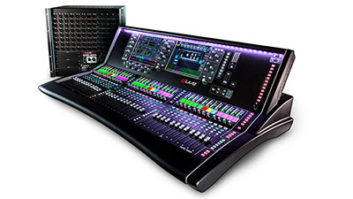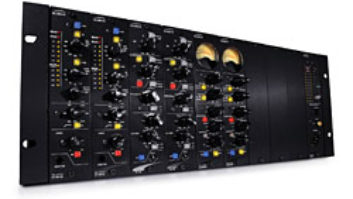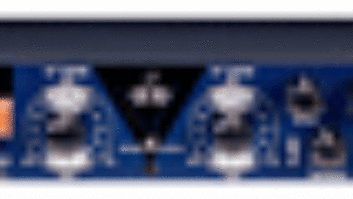Most audio processing takes place today within a CPU. So our most relied upon hardware (other than the CPU itself) is often a comprehensive I/O unit featuring ample microphone preamps and the necessary portals for, ideally, near-zero roundtrip latency.
Such I/O options are increasingly small (often 1U thick) considering their capabilities, and may feature a variety of hardware interfaces, or perhaps just one that’s blazingly fast, like Thunderbolt. Either way, a modern, on-the-go audio content creator really can’t go wrong with any of the following choices in I/O.
Antelope Audio’s Orion32+ and Orion Studio interfaces are fully compatible with Apple Thunderbolt technology. Orion32+ features 32 channels of I/O within a compact 1U rackspace. Features include 24-bit, 192kHz performance; zero-latency monitoring; comprehensive connectivity with ADAT and S/PDIF throughput, D-Sub 25 analog I/O, etc.; and 129 dB of dynamic range via “mastering grade” monitor outputs. The Orion Studio is a 24-bit, 192kHz-capable 32-channel I/O featuring USB compatibility; fast operation; 12 commercial-quality microphone preamplifiers; 16 analog outputs; and more. Orion32+ and Orion Studio software for OS X and Windows OS features a color-coded routing matrix, four separate mixers and DSP effects integration.

Ideal for Apple Logic users, Apogee Electronics announced its new Element series of three Thunderbolt audio interfaces for Mac—the 192kHz/24-bit capable Element 24, Element 46 and Element 88—last year at AES, each with a different number of analog and digital I/O. Element 24 offers 10 in, 12 out; Element 46 offers 12 in, 14 out; and Element 88 offers 16 in, 16 out. While Apogee explains that the Element series’ performance is comparable to its impressive Ensemble series, but is more affordable and streamlined to best serve a broader range of potential users. The Element series 48V phantom-power ready preamps are indeed low-latency; they reportedly perform a 1.41 ms roundtrip latency at 96 kHz with a 32-buffer setting when using Apple’s Logic Pro X DAW.


For those who don’t need a direct connection to their CPU—or for users of the popular Audient iD Series who need more than two microphone preamps—the Audient ASP880 is a great-sounding, traditionally styled 8-channel microphone preamplifier with 48V phantom power, Burr-Brown A/D converters, variable input impedance, variable highpass filters, eight useful insert points, and dual DI instrument inputs. Digital outputs include ADAT, AES and S/PDIF.
Specifically built for Pro Tools users, Avid’s PRE is an 8-channel digitally controlled preamplifier that is adjustable from its front panel or entirely within Pro Tools, or an associated Avid controller. Each input supports XLR, DI or TRS line-level inputs. DB-25 outputs are provided for universal analog connectivity, too. All eight channels are provided insert points as well as highpass filter, phase reversal and 48V phantom power.

Affordable and well-equipped with I/O options, Behringer’s Firepower FCA1616 is a 16 in, 16 out 24-bit/96kHz-capable multichannel preamplifier/interface featuring FireWire, USB, MIDI, ADAT, S/PDIF, etc., connectivity. Key features include four Midas-designed microphone preamplifiers with phantom power, individual pad, low-cut and high-impedance selectivity eight analog inserts, and much more. Most attractively, the unit is priced at a low $249.99 street.
DiGiGrid IOS, an audio interface with a built-in SoundGrid DSP server for plugin processing developed by Waves and DiGiCo, features eight mic/line inputs, eight line outputs, dual headphone outputs, and MIDI I/O, S/PDIF, and AES ins and outs. Connectivity is via a single Ethernet cable (Cat 5e/Cat 6). Notably, IOS comes with SoundGrid Studio System software, including the SoundGrid Studio application, StudioRack, and the eMotion ST mixer. This allows mixing and monitoring, in real time, with SoundGrid-compatible Waves and third-party plug-ins with incredibly low latency (0.8 milliseconds).

Focusrite’s largest multichannel preamp in its Red Series of interfaces, the 8Pre, offers a whopping 64 ins, 64 outs and eight digitally controlled Red Evolution mic pre’s with 63 dB of gain. With 16 analog inputs and 18 analog outputs, the unit also includes two front-panel instrument inputs. Further, its connectivity is impressive—options of Thunderbolt 2, dual Pro Tools | HD DigiLink, and Dante AoIP are included. The unit’s software control allows recall of settings and stereo linking, as well as configuration of HPF, polarity flip and individual phantom power. The preamps (and other parameters) can be adjusted from the front panel and include Focusrite’s ‘Air’ effect, re-creating in the analog domain the sound of the transformer-based mic preamps in the ISA range.

Grace Design’s m108 is a high-performance 8-channel preamp with eight inputs and two outputs featuring USB 2.0 connectivity. Evolved from the beloved m802, its eight transformerless mic preamps feature 192kHz A/D conversion. Dual quarter-inch Hi-Z inputs for channels 1 and 2 are included plus quarter-inch stereo headphone output with dedicated volume control. Buttons for +48V phantom power, mute, phase reverse, solo, Peak Clear, setup, Group and Pan control are included on its front panel. A high-contrast OLED displays all the functionality of the eight preamp channels and associated Global settings. Notably, an Edit knob controls the m108’s functions and allows navigation around the setup menu. Other features include DB-25 analog out, AES3 out, dual ADAT outputs, Word Clock I/O, RS422 MIDI I/O for Pro Tools HD control and an Ethernet jack for IP control.

Millennia Media’s HV-3R is the remote-controllable version of its HV-3D 8-channel multichannel microphone preamplifier. Controllable via Ethernet on Millennia’s AELogic PC software, as well as via MIDI, the HV-3R has available Dante, AES and MADI output options, too. For world-class, large–channel count purposes, the HV-3R is matchless; the unit supports control of up to 792 channels (or 99 HV-3R units) simultaneously.

MOTU has long been known as a super source for multichannel preamp/interface options, and the company’s 1248 is an ideal example of the kind of feature-packed units we are examining here. Featuring 32 ins, 34 outs and four built-in microphone preamps, the 1248 offers Thunderbolt, USB 2.0 and iOS connectivity (via Apple’s Camera Connection Kit) for use with iPad-based DAWs such as WaveMachine Labs’ Auria, making the 1248 a superb all-in-one field recording solution. Other features include a built-in DSP mixer with processing and effects, ADAT and S/PDIF I/O, AVB Ethernet networking capability and more.

PreSonus’ Studio 192 USB 3.0 is the most comprehensively featured of its rackmountable interfaces with 26 ins, 32 outs, eight remote-controllable Class A microphone preamps, DSP-powered “Fat Channel” EQ and dynamics processing on all inputs, and much more. Notably, the Studio 192 includes a complete monitoring section with talkback microphone, dim and mute functions, as well as dual headphone outputs with independent source selection. For those recordists using (or considering) PreSonus’ burgeoning DAW Studio One, this unit is optimized for it; Studio One Artist is included, though it works swimmingly with essentially any DAW on the marketplace. Best of all, for all that it is, the Studio 192 is affordably priced at $899 street.
When it comes to feature-packed, high-quality audio interfaces, Germany’s RME are true experts, having packed mind-blowing amounts of features and functionality into a 1U chassis for years now. Their latest accomplishment is the impressive Fireface UFX+, capable of handling up to 94 channels of I/O while offering USB 3.0 and super-low latency Thunderbolt connectivity. Key features include four microphone preamps with 75 dB of gain; MADI I/O; built-in TotalMix FX mixer for input, output, mix level, etc., control; and available ARC USB desktop controller. Most notably, the RME doesn’t even need a CPU to capture multitrack audio; simply insert a thumb drive into its front panel DURec USB slot for capturing of up to 76 simultaneous channels. I am currently reviewing this unit and am already blown away by its capabilities, even though I’ve tapped maybe 20 percent of what it can do.

Steinberg’s UR824 is a 24-bit/192 kHz-ready USB 2.0 audio interface featuring 24 ins, 24 outs, and eight D-PRE microphone preamps with dspMixFX, a latency-free DSP-powered monitoring system with REV-X reverb, Sweet Spot Morphing channel strip and various guitar amp simulations. Although Cubase and Cubasis are included, the UR824 is compatible with all major DAWs. Its two pair of ADAT optical I/O provide 16 ins and outs, which are S/MUX-compatible, 4 in and 4 out at 192 kHz.

Tascam’s 24-bit/192 kHz-capable Celesonic US-20×20 offers 20 channels of analog and digital I/O paired with USB 3.0/2.0 connectivity for an affordable $499 street. Built to serve in a number of applications, the US-20×20 operates as an audio interface, digital mixer and 8-channel digital mic preamp. The unit features Tascam’s Ultra-HDDA microphone preamps with 56 dB of gain; ten channels of digital I/O via ADAT and S/PDIF connectors; word clock and MIDI I/O; and a built-in DSP mixer with parametric EQ and compression on every channel. The unit also includes a stereo reverb.

Universal Audio’s Apollo 8p is arguably the sexiest 8-channel preamplifier/interface on the market, featuring eight Unison-enabled mic preamps, onboard UAD-2 QUAD Core processing, and an included bundle of award-winning UAD plug-ins (the latter being the sexy part). Apollo 8p offers 16 ins, 20 outs, and two built-in Thunderbolt ports. UA users can quickly increase the number of inputs by adding other Apollo units into the system. UA also gets bonus points for its Console 2.0 application, allowing comprehensive control of what’s going on inside the Apollo 8p.
Zoom’s TAC-8 is a Mac-ready 24-bit/192kHz-capable 18-in, 20-out Thunderbolt interface featuring eight microphone preamps with a wide range of uses. In standalone mode, it can be used simply as an 8-channel mic preamp and A/D or D/A converter, no CPU needed. Other features include 10 balanced TRS output jacks, dual front-panel headphone outputs with dedicated volume knobs, ADAT and S/PDIF I/O, Word Clock and MIDI I/O, and much more.

Strother Bullins is Technology Editor for NewBay Media’s AV/Pro Audio Group.




